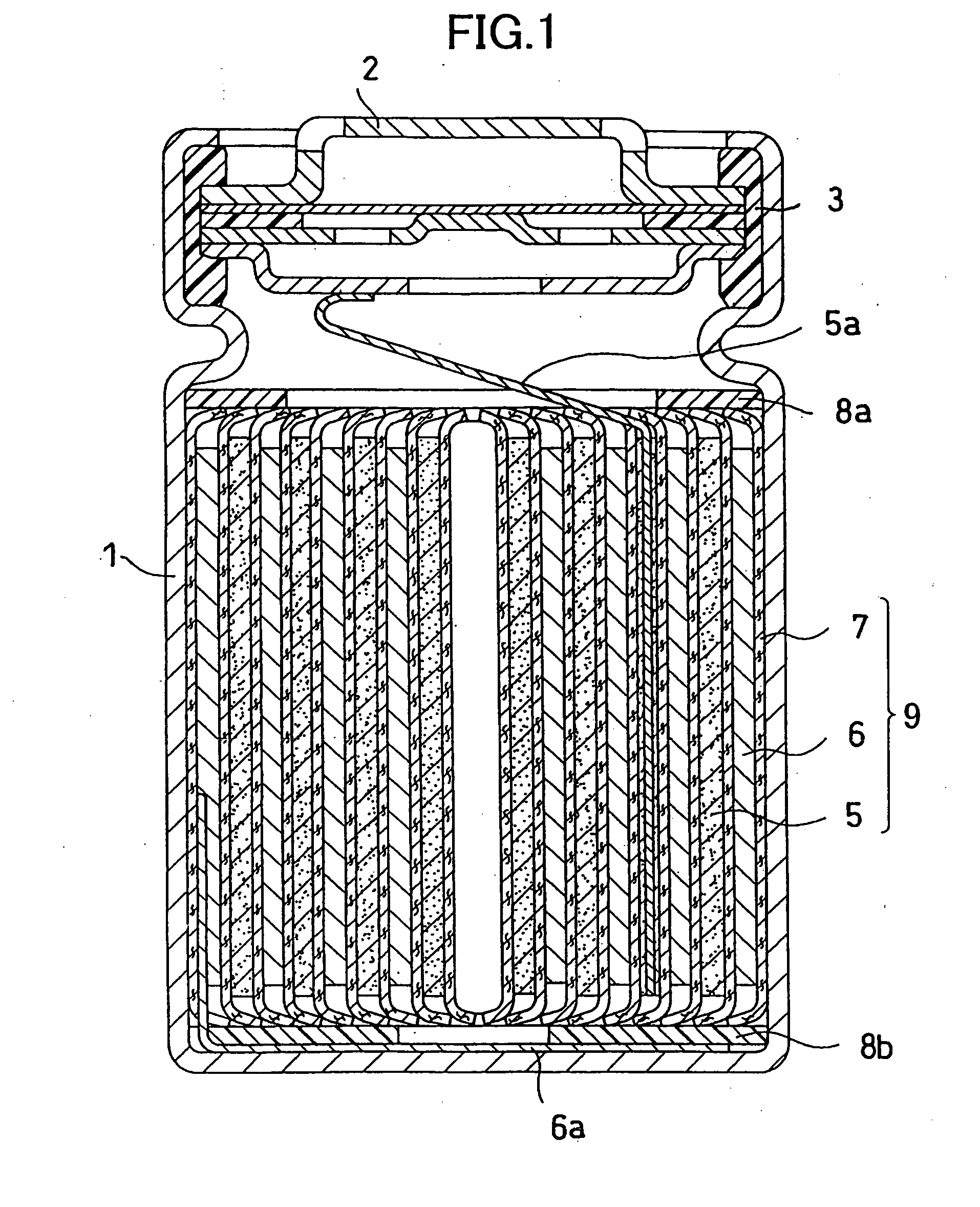Nonaqueous electrolyte secondary battery and method for manufacturing the same
- Summary
- Abstract
- Description
- Claims
- Application Information
AI Technical Summary
Benefits of technology
Problems solved by technology
Method used
Image
Examples
embodiment 1
[0054]Embodiment 1 of the present invention takes a lithium ion secondary battery as an example of the nonaqueous electrolyte secondary battery. The structure of the lithium ion secondary battery will be explained below.
[0055]FIG. 1 is a vertical sectional view illustrating the structure of the lithium ion secondary battery of the present embodiment. FIG. 2 is a sectional view illustrating the structure of an electrode group 9 included in the lithium ion secondary battery of the present embodiment. FIG. 3 is a graph illustrating a general temperature characteristic of a positive electrode active material.
[0056]The lithium ion secondary battery of the present embodiment includes, as shown in FIG. 1, a stainless steel battery case 1 and an electrode group 9 placed in the battery case 1.
[0057]The battery case 1 has an opening 1a at the top thereof. A sealing plate 2 is crimped to the opening 1a with a gasket 3 interposed therebetween. The opening 1a is closed by crimping the sealing pl...
second embodiment
[0124]In Embodiment 2, a porous insulating layer material different from that used in Embodiment 1 is used. Hereinafter, the difference between Embodiments 1 and 2 will be described.
[0125]FIG. 5 is a sectional view illustrating the structure of an electrode group 19 of the present embodiment.
[0126]The electrode group 19 of the present embodiment includes, just like that of Embodiment 1, a positive electrode 5, a negative electrode 6 and a porous insulating layer 17. The positive electrode 5 includes PTC layers 53 and the negative electrode 6 includes PTC layers 63. The porous insulating layer 17 contains a material which does not have a shutdown function (not shown).
[0127]According to the present embodiment, the material which does not have a shutdown function is a material which does not cause shutdown at a temperature lower than 130° C. but causes the shutdown at a temperature not lower than 130° C. The material which does not have the shutdown function of the present embodiment i...
third embodiment
[0131]In Embodiment 3, the structure and the manufacturing method of the electrode group are different from those of Embodiment 1. In the following description, the difference from Embodiment 1 will be explained.
[0132]FIG. 6 is a sectional view illustrating the structure of an electrode group 29 of the present embodiment and FIG. 7 is a sectional view illustrating part of an electrode group of a comparative embodiment.
[0133]The electrode group 29 of the present embodiment includes a positive electrode 25, a negative electrode 26 and a porous insulating layer 7. The positive electrode 25 includes PTC layers 53 and the negative electrode 26 includes PTC layers 63.
[0134]The PTC layers 53 and 63 contain a material having a positive temperature coefficient of resistance, respectively, just like those of Embodiment 1. However, unlike the PTC layers of Embodiment 1, the PTC layers 53 are provided in the positive electrode material mixture layers 52, respectively, and the PTC layers 63 are ...
PUM
 Login to View More
Login to View More Abstract
Description
Claims
Application Information
 Login to View More
Login to View More - R&D
- Intellectual Property
- Life Sciences
- Materials
- Tech Scout
- Unparalleled Data Quality
- Higher Quality Content
- 60% Fewer Hallucinations
Browse by: Latest US Patents, China's latest patents, Technical Efficacy Thesaurus, Application Domain, Technology Topic, Popular Technical Reports.
© 2025 PatSnap. All rights reserved.Legal|Privacy policy|Modern Slavery Act Transparency Statement|Sitemap|About US| Contact US: help@patsnap.com



